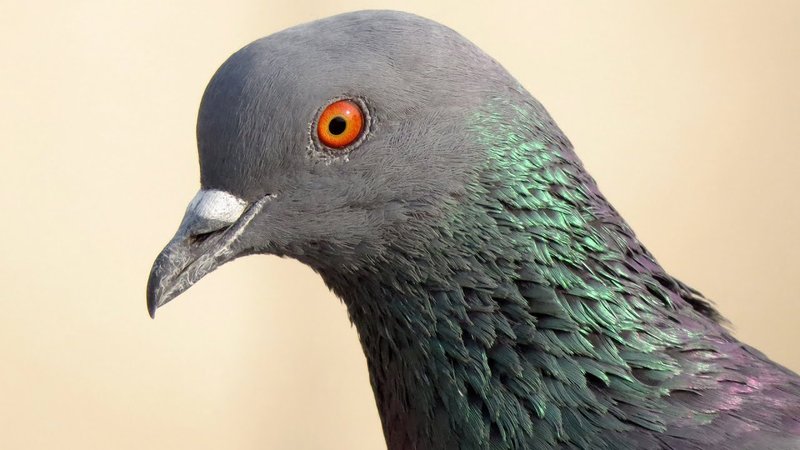
Think about it like this: Imagine if every time you felt happy, sad, or wanted to greet a friend, you had a specific sound just for that. That’s how pigeons communicate. While it might seem simple at first, their vocalizations contain layers of meaning. So, grab a cup of coffee and let’s dive into the world of rock pigeon vocalizations and what they really mean.
The Basics: What is a Rock Pigeon?
Before we dig into their sounds, let’s quickly cover what a rock pigeon actually is. Rock pigeons, also known as Columba livia, are medium-sized birds that are often mistaken for doves. With their blue-grey feathers and two black stripes on each wing, they have a striking appearance. Found all over the world, they’ve adapted well to urban environments, making themselves at home in our cities.
These birds are known for their intelligence and strong homing abilities. They can navigate their way back home from hundreds of miles away. You might have seen them pecking at crumbs on the sidewalk or perched on rooftops. Their ability to thrive alongside us has given them a reputation, but understanding their vocalizations can reveal a lot more about their behavior and social dynamics.
Common Vocalizations of Rock Pigeons
Rock pigeons have a variety of sounds that they use for different purposes. The two main types of vocalizations are cooing sounds and harsh calls.
- Cooing: This is perhaps their most well-known sound. A soft, rhythmic coo—often a few syllables long—is typically associated with courtship or expressing calmness. It’s like a gentle song that signals pleasure or affection.
- Harsh Calls: These sounds are usually shorter and sharper. Pigeons make harsh calls when they feel threatened or are trying to warn others about danger. Think of it as their version of shouting “Watch out!”
By recognizing these key sounds, pigeon enthusiasts and casual observers can understand when a pigeon is in a relaxed state or when it’s on high alert.
Why Do Rock Pigeons Coo?
Cooing plays a vital role in pigeon communication, especially during the breeding season. This soothing sound is often made by males to attract females. It’s akin to a man serenading his love interest; it signals affection and readiness to mate.
But there’s more to it than just romance. Cooing can also serve as a way to establish territory. When a male coos, he’s not just singing sweet nothings; he’s declaring, “This is my space!” Other males in the vicinity are likely to hear it and understand that they should keep their distance.
Think of it this way: when someone confidently takes the stage at an open mic night, their presence and performance can deter other aspiring singers from stepping up. The same goes for pigeons. Their vocalizations help maintain order in their social groups.
The Role of Vocalizations in Social Interaction
Rock pigeons are quite social creatures. They thrive in flocks, and their vocalizations help maintain group cohesion. When you see a bunch of them huddled together, you might notice the ambient cooing sounds. This chatter helps strengthen their bonds and keeps everyone connected.
You might also witness pigeons engaged in what looks like a conversation—one coos, and then another responds. This back-and-forth is crucial for reinforcing relationships within their flock. It’s a lot like friends catching up over coffee, sharing stories, and laughing together.
Interestingly, each pigeon can develop its unique vocal patterns over time. It’s like how friends start to pick up quirky phrases or accents from one another. This individual flair can contribute to the overall dynamic of the flock.
Understanding Alarm Calls and Their Importance
When pigeons perceive danger, their vocalizations change dramatically. The sharp, alert sounds serve as alarm calls that warn others of predators or threats nearby. This communication is vital for survival.
If you’ve ever watched a pigeon scatter suddenly, it’s often preceded by an alarm call. It’s their way of saying, “Something’s not right!” This type of urgent vocalization creates a sense of urgency among the flock, helping them to react swiftly.
Imagine you’re at a picnic and someone shouts “Bear!” Everyone’s instinct would be to run. Pigeons work the same way, ensuring that their cohort can escape danger together.
The Impact of Environment on Vocalizations
Just like people can adjust how they speak based on their surroundings, rock pigeons do too. In bustling city environments, their vocalizations may become slightly louder or more pronounced to be heard over the noise of traffic and chatter.
In quieter areas, their sounds can become softer, allowing them to communicate without drawing too much attention. This adaptability shows how in tune these birds are with their environments, responding to the unique challenges they face.
It’s a fascinating dance of survival—and it highlights how critical their vocal abilities are. By adjusting their sounds, they can effectively convey their needs and emotions, no matter where they are.
Caring for Rock Pigeons: The Role of Human Interaction
If you’ve ever fed pigeons in the park, you’ve likely seen their vocal responses. The cooing and gentle calls when they approach for food express their gratitude and excitement. This interaction can strengthen the bond between humans and these birds, though it’s essential to approach feeding responsibly.
However, it’s important to remember that if you want to support rock pigeons, their well-being goes beyond occasional feedings. Maintaining clean habitats, minimizing pollution, and preserving their nesting areas can significantly impact their populations and vocal behaviors.
Consider it like maintaining a friendship. It’s not just about the good times; it’s about creating a supportive environment overall.
Rock pigeons are more than just urban fixtures; they have a rich and nuanced language that reveals their emotions and social dynamics. Their cooing and alarm calls are not just sounds; they are meaningful expressions that enhance their survival and social structures.
Next time you hear a rock pigeon, take a moment to listen. You might be surprised at what their vocalizations can tell you. Whether they’re expressing love, warning of danger, or simply chatting with friends, these birds offer a fascinating insight into communication in the animal kingdom.
So, the next time you’re out for a walk and encounter these feathered friends, pause and appreciate the symphony of sounds they create—it’s a little reminder of the vibrant life that surrounds us.

